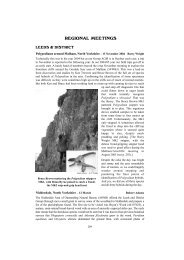Full Contents as pdf File - Natural History Museum
Full Contents as pdf File - Natural History Museum
Full Contents as pdf File - Natural History Museum
Create successful ePaper yourself
Turn your PDF publications into a flip-book with our unique Google optimized e-Paper software.
Porlock. During the drive over to Porlock, Nick Hards and some of the party stopped to<br />
inspect the ferns on the high moorland at Chetsford Water (21/847420). Oreopteris<br />
limbosperma w<strong>as</strong> particularly abundant there.<br />
Joan met us at her gate and<br />
ushered us onto the lawn at the<br />
side of the house where she gave<br />
us a talk on the recognition of<br />
Polystichum setiferum and its<br />
varieties. After a most interesting<br />
talk and armed with maps of the<br />
garden, we explored the various<br />
ferns that Joan had kindly drawn<br />
to our attention. It had been some<br />
ten years since my l<strong>as</strong>t visit to<br />
Greencombe and it had lost none<br />
of its charm. Indeed, Joan had<br />
added a new dimension to the<br />
garden, which many of us found<br />
quite a delightful surprise. At the<br />
far end of the garden she had built<br />
a small, round timber building.<br />
Described <strong>as</strong> a Millennium Chapel,<br />
a few seats were arranged around<br />
the sides of the building and a<br />
representation of the Holy Mother<br />
and Child, exquisitely carved from<br />
sweet chestnut, provided a focal<br />
photo: P.J. Acock point for quiet contemplation. The<br />
site chosen, with its wooded<br />
Joan Loraine talks to members about her garden<br />
surroundings, provided an ideal<br />
site for peaceful reflection. I had always considered Greencombe <strong>as</strong> a truly remarkable garden<br />
but this new addition gives a totally new and perhaps unique corner. At the end of our garden<br />
tour, Joan kindly invited us into her home to enjoy tea with home-made scones and cakes.<br />
Some of the party stopped in the car park at Lynmouth, from where a short walk along<br />
the sea front enabled them to admire the Asplenium marinum on the sea wall and cliffs<br />
(21/721498). During the ‘recce’ this species had also been found in the Valley of the<br />
Rocks, to the seaward side of C<strong>as</strong>tle Rock, where it w<strong>as</strong> not found during the Society’s<br />
previous visit. Returning to Lynton, we all gathered at the Bridge Inn for evening drinks<br />
and supper at the end of a very successful and ple<strong>as</strong>ant day.<br />
Sunday dawned bright and clear and we all made our way the short distance to Watersmeet<br />
(21/744486), arguably the most scenic part of Exmoor. We made our way down into the<br />
gorge. Here we were able to add to the previous day’s list with Polystichum setiferum and<br />
Hymenophyllum tunbrigense. In spite of diligent searching we were unable to find its<br />
companion, H. wilsonii. Another item of interest w<strong>as</strong> the occurrence of the gametophyte<br />
stage of Trichomanes speciosum in a small cave opposite the Watersmeet tea rooms and<br />
National Trust shop.<br />
Loth <strong>as</strong> we were to leave such a ferny setting, we went on our way and stopped at a car park<br />
on the high cliffs to take advantage of the panoramic view across the Severn estuary.<br />
Descending into the Hebden Valley we made our way to the Hunters Inn where Paul had<br />
thoughtfully reserved tables for our lunch.<br />
112

















